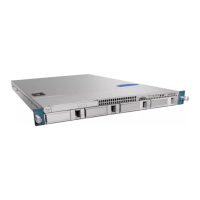2-11
Cisco UCS C200 Server Installation and Service Guide
OL-20732-02
Chapter 2 Installing the Server
Initial Server Setup
d. Use this utility to change the NIC redundancy to your preference. This server has three possible NIC
redundancy settings:
–
None—The Ethernet ports operate independently and do not fail over if there is a problem.
–
Active-standby—If an active Ethernet port fails, traffic fails over to a standby port.
Active-active—All Ethernet ports are utilized simultaneously. See NIC Modes and NIC
Redundancy Settings, page 2-12 for more information.The active/active setting uses Mode 5 or
Balance-TLB (adaptive transmit load balancing). This is channel bonding that does not require any
special switch support. The outgoing traffic is distributed according to the current load (computed
relative to the speed) on each slave. Incoming traffic is received by the current slave. If the receiving
slave fails, another slave takes over the MAC address of the failed receiving slave.
–
e. Choose whether to enable DHCP for dynamic network settings, or enter static network settings.
Note Before you enable DHCP, your DHCP server must be preconfigured with the range of MAC
addresses for this server. The MAC address is printed on a label on the rear of the server. This
server has a range of six MAC addresses assigned to the CIMC. The MAC address printed on
the label is the beginning of the range of six contiguous MAC addresses.
f. Optional: Use this utility to make VLAN settings, and to set a default CIMC user password.
Note Changes to the settings take effect after approximately 45 seconds. Refresh with F5 and wait
until the new settings appear before you reboot the server in the next step.
g. Press F10 to save your settings and reboot the server.
Note If you chose to enable DHCP, the dynamically assigned IP and MAC addresses are displayed on the
console screen during bootup.
Step 4 Connect to the CIMC for server management. Connect Ethernet cables from your LAN to the server by
using the ports that you selected by your NIC Mode setting in
Step 3. The Active-active and
Active-passive NIC redundancy settings require you to connect to two ports.
Step 5 Use a browser and the IP address of the CIMC to connect to the CIMC Setup Utility. The IP address is
based upon the settings that you made in
Step 3 (either a static address or the address assigned by your
DHCP server).
Note The default user name for the server is admin. The default password is password.
Step 6 To manage the server, see the Cisco UCS C-Series Rack-Mount Server Configuration Guide or the Cisco
UCS C-Series Rack-Mount Server CLI Configuration Guide for instructions on using those interfaces.
The links to these documents are in the C-Series documentation roadmap:
http://www.cisco.com/go/unifiedcomputing/c-series-doc
To install or replace hardware components, see the “Maintaining the Server” section on page 3-1.

